The Australian Blue Tongue Lizard
Meet Our Blue-Tongued Lizards. Facts And Pictures.
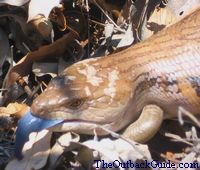
The Australian blue tongue lizard is one of the first lizards I came to know when I arrived in Australia.
The reason is that these big friendly skinks are very slow moving. They are easy to observe and easy to catch. Something that can't be said for many other lizards.
I had no problem getting close enough to this blue tongued lizard (it's one of several living in my garden) to get a picture of its vivid blue tongue.
Blue tongue lizards quickly become used to humans. (That's one reason why they are so popular as pets.)
But even if they've never seen any humans before they are likely to just sit there and let you pick them up when you see one. (Though they don't really like being handled. They prefer firm ground under their feet. I don't blame them.)
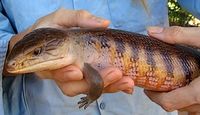
Let's have a closer look at these gentle creatures, their habits and their habitat, and the way they use their blue tongue.
Australian Blue Tongue Lizard Species
There are six species of blue-tongued lizards or skinks in Australia. They vary a bit in colour and size, but most commonly they are grey with broad brown stripes across their back and tail, and they grow to around a foot in length (that's just the head and body, not the tail).
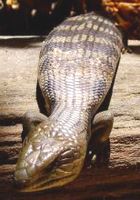
Common or Eastern Blue-tongue Lizard (Tiliqua scincoides scincoides): this one is widespread in the south east of Australia and looks just as described above, grey with dark stripes.
Northern Blue-tongued Skink (Tiliqua scincoides intermedia): belonging to the same species, this form is at home on the savannahs of Australia's tropical regions. (And in my garden. You can see one in the photos at the top).
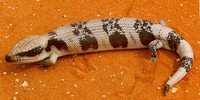
Picture under GNU Free Documentation License
Western blue-tongued skink (Tiliqua occipitalis): listed as vulnerable

Photo under GNU Free Documentation License
Central blue-tongued skink (Tiliqua multifasciata): listed as vulnerable
Blotched Blue-tongue (Tiliqua nigrolutea): another species from the south west, this one is restricted to the highland areas. It looks slightly different, being dark brown with light coloured blotches across the back.
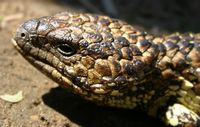
Shingleback (Tiliqua rugosa): the Shingleback has many names, like Bob-tailed Lizard, Sleepy Lizard or Stumpy-tailed Lizard. It can be found west of the Great Dividing Range. It's the most unusual looking of the blue-tongue lizards with its very short, stumpy tail and large rough scales. The Shingleback too is dark brown, with or without blotches.
Pygmy Blue-tongue Skink (Tiliqua adelaidensis): as you probably guessed, the Pygmy Blue-tongue is a little fellow, growing to about 90 mm. It was considered to be extinct until it was rediscovered near Burra (mid-north of South Australia). The species is confined to that very small area north of Adelaide and is listed as endangered.
Australian Blue-Tongue Lizard Facts
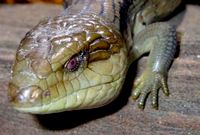
Blue tongues have somewhat unusual body proportions: a big head and long body with very short legs and small feet. Their evenly tapering tail is fat and shorter than the body.
Male lizards have a proportionally larger head than females, but the females are bigger overall.
The most noticeable feature of these lizards is the blue tongue inside the bright pink mouth.
Like all reptiles they do not produce any body heat. Their body temperature depends on the surrounding temperature and they can be found sun basking in the mornings or during cooler days. On cold days they remain inactive in their shelter. (They need a body temperature of 30 to 35°C to be active.)
Their diet consists of plant matter and small animals. That can be beetles, caterpillars, crickets, snails and even other small lizards. Anything they can get hold of will do. But they are not very fast, so they usually eat slower critters. They are very partial to slugs and snails. Oh, and they steal dog food...
Blue-tongue lizards have strong jaw muscles to crush big beetles and snail shells. They may also bite in defence when they feel threatened.
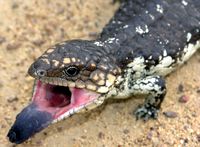
Picture under GNU Free Documentation License
The blue tongue's main defence strategy is bluff:
It faces the threat and opens its mouth. The blue tongue inside the pink mouth is an unexpected and vivid sight, designed to frighten off the attacker.
The lizard also hisses loudly and flattens its body which makes it look wider and bigger.
If you pick the lizard up now it will bite you. And it will hurt. Blue tongues have a habit of latching onto your finger and not letting go, which leaves you with a nice bruise.
Blue-tongued Lizard Habitat And Life Cycle
Blue-tongues occur across most of Australia. They like open country with lots of cover like tall grasses, leaf litter, rocks and logs, low shrubs etc. under which they will shelter at night. (They also like burrows).
During the day they sun themselves until they are warm enough, and then they forage for food during the warmer parts of the day.
Blue-tongue lizards live alone for most of the year. It's only during the mating season between September and November that the male will pursue females (and fight other males). Mating is a rough affair and many females carry scars from the male's teeth...
Female blue tongues stay within a defined home base. The males wander over an area the size of about 15 house blocks and have several females. (Does something sound familiar here or what?)
Blue tongues are born alive, about three to five month after mating. From the moment they are born they have to look for food themselves (they start by eating the placenta), and they will be off on their own within a few days.
The Common Blue-tongue Lizard has the largest litter (up to 25 young at once) and the smallest young. The baby blue-tongue lizards are 13 to 14 cm long and weigh 10 to 20 g. The Shingleback is at the other end of the scale with only two or three young, about 22 cm in size and weighing 200 g.
The Common Blue-tongued Lizard breeds annually, but other species breed only every second year. How often they breed also depends on the amount of food available.
A lucky blue-tongued lizard can live for many years. Lizards in captivity have lived for as long as 20 years, and some in the wild may live for up to 30 years.
The main predators that may cut a blue-tongued lizard's life short are lawn mowers, cars, and cats and dogs. Cats are the worst. Dogs are often perplexed enough by the blue tongue and the threatening behaviour of the lizard to keep a distance. But cats are ambush predators and the lizard doesn't get a chance to show its scary tongue...
Baby blue tongues may also end up as dinner for currawongs, kookaburras, raptors or snakes.
Blue-tongued lizards can drop their tails if necessary to escape a predator. The stump will heal quickly and a new tail will start to grow. It takes about a year for the new one to fully regenerate. That's if the lizard has a stable food source. All the food and water reserves are stored in the tail. If the tail is lost the skink has nothing to fall back on and needs a steady supply.
Blue Tongues In Your Garden
Blue-tongue lizards are an asset in the garden as they keep the numbers of snails, caterpillars and other pests down.
It's not hard to make your garden blue-tongue lizard friendly. All they need is plenty of shelter and food. If you have lots of rocks and logs on the ground, piles of leaves, mulch, ground covers and low shrubs, then you are taking care of both requirements. Because beetles, spiders, snails and other critters will like the many moist and protected hidey-holes too.
The quickest way to wipe out your blue-tongue lizard population is to use snail pellets. Blue tongues love snails and can't go past them. The lizards eat the poisoned snails and die as well. The snail population will recover, the lizard population won't. (It's a typical scenario that replays over and over again wherever people use chemicals to control pests.) Leave the snail control to the lizards, they will eventually catch up. Don't panic if you see a few snails. You need a few or the blue tongues will go hungry.
The other thing to be careful of is blue tongue lizards hiding in the grass when you are mowing. The noise will not scare them away. Rather they will turn around and threaten the lawn mower with their blue tongue, which in this case is somewhat ineffective.
Keep your cat indoors (which you should anyway), teach your dog to share its food (a good poke in the ribs whenever it looks in a lizard's direction has worked well in this household), and of course, don't run your blue tongue lizard over on your driveway while it tries to get warm enough to move.
Read about other Australian Lizards | Return to top
All Australian Animals | Australian Outback Animals
Return from Australian Blue Tongue Lizard to Outback Australia Travel Guide home page





